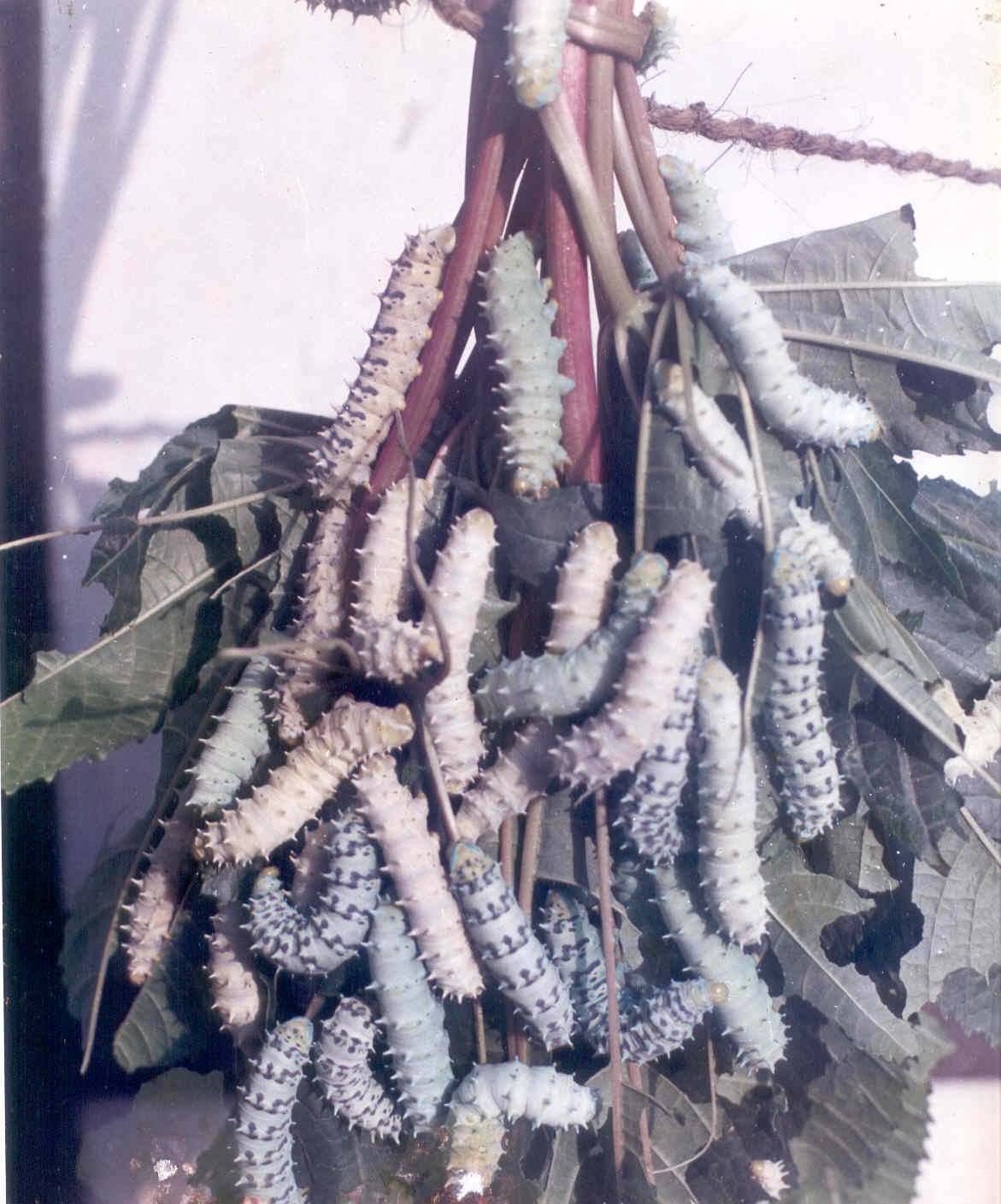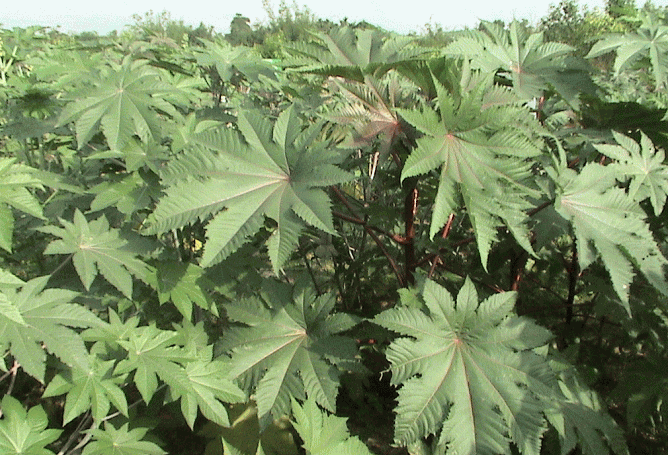सिल्क कीट के मेजबान पौधे अरण्डी की खेती
Northeastern region of India is rich in diversity of sericigenous insects and their host plants, out of which, four types namely Muga (Antheraea assamensis), Eri (Samia ricini), Oak tasar (Antheraea proylei) and Mulberry (Bombyx mori) silkworm have been commercially exploited for silk production.
 The Eri silkworm is multivoltine and polyphagous sericin producing insects. Eri culture is a traditional agro-based small scale industry, primarily practiced to meet the partial need of warm clothing. Moreover, eri pupae are popular as delicacy among the tribal people of this region. Proximate analysis of pupa showed that it contains 55-60% protein, 25-30% lipid, 4.96% fiber, and other substances, e.g. hormones, trace elements and vitamins, thus indicating that it could be a good protein source-for various purposes (Sharma, 2010).
The Eri silkworm is multivoltine and polyphagous sericin producing insects. Eri culture is a traditional agro-based small scale industry, primarily practiced to meet the partial need of warm clothing. Moreover, eri pupae are popular as delicacy among the tribal people of this region. Proximate analysis of pupa showed that it contains 55-60% protein, 25-30% lipid, 4.96% fiber, and other substances, e.g. hormones, trace elements and vitamins, thus indicating that it could be a good protein source-for various purposes (Sharma, 2010). Eri silkworm significantly contributes to the Indian commercial silk production which is mostly confined to the Brahmaputra valley of Assam in the tribal inhabited districts. Approximately, 1.3 lakh families with plantation area of 26000 hectares are involved in ericuluture in northeastern region of this country. Annual production of eri raw silk has significantly increased from 974 MT in 1999-2000 to 2460.50 MT in 2009-10. It is also practiced in few districts of the neighbouring states mainly Meghalaya, Nagaland, Manipur and Arunachal Pradesh. A small quantity of Eri cultivation is also spreading recently to some other parts of the country. The north eastern region of India alone produces more than 90 % of the total amount of cut cocoons and spun silk in the country.
Eri silkworm has been classified into six different homozygous strains on the basis of body colour and subdivided into eight eco-races on the basis of their ecological distribution. Cocoon colours of eri silkworm are generally white to off-white except in Kokrajhar race, which produces brick red coloured cocoon. Moth colour is variable, but always solidly white on the dorsal surface of the abdomen. Ground colour is usually light or dark grayish brown, rarely reddish, but occasionally olive gray. Wing pattern was heavily marked whiter in ante median and post median lines.
 Eri host plant
Eri host plant
CASTOR CULTIVATION
Package & Practices
Castor (Ricinus communis Linn.) is grown as annual plant or by a few as biannual plants for feeding purpose to eri silkworm. Propagation is done by sexual method, by sowing of seeds in the field prepared systematically for raising.
Soil types
Almost all types of soils like red soil, sandy loam soil, light alluvial soil is suitable for castor cultivation. Light clay or light sandy soil with higher organic matter is ideal for better leaf yield. Castor is susceptible to water stagnation, so select plain elevated land with proper drainage system in the planting area.
Climate
Castor can withstand long dry spell and heavy rain. It grows well in relatively dry and warm region having sufficient rainfall. For better yield castor requires moderately high temperature with low humidity through out the growing season. Castor plants die even from slight frost or extreme cold, as the collateral vascular bundles are not protected by bark.
Season
As castor is a warm season crop, the ideal season for plantation of castor is March to April and September to October in the northeast region of India. During winter season (long dry spell), its leaf yield gets considerably reduced. Always avoid sowing in rainy season.
Varieties
A non-bloomy red variety of castor (NBR-1) was found promising in terms of growth, yield and palatability and was recommended for Eri silkworm rearing. In addition, High leaf yielding varieties like NBG, Kalpi-6, DCH-177 and GCH-4 may also be raised.
Agronomical practice
Tillage
Land should be pulverized by 2-3 times ploughing followed by cross ploughing to a depth of 20-25 cm. Remove the weeds, make proper tilt and level for facilitating good root penetration.
Spacing
For castor cultivation pit system of plantation is followed with size of 20x25x25 cm pits are to be prepared maintaining 1x1 m spacing. Apply 1 kg FYM in each pit as basal dose and mixed properly with soil.
Seed Treatment
Soak castor seeds in water for 24 hrs and treat with Bavistin or Thiram @ 3 gm/Kg for 10-15 minutes before sowing to check fungal infestation. Always discard unhealthy / dry seed prior to sowing.
Sowing
Two seeds per pit at a depth of 2.5-3.0 cm are to be sown. Germination takes place after 7-10 days and only one healthy seedling per pit has to be allowed for vigorous growth after germination.
Fertilizer application
In addition to organic manures (FYM), chemical fertilizer NPK @ 90:40:20 kg/ha is recommended as the 1st dose after one month of germination, at the base of the plant by making ring (Urea: SSP: MOP=20gm: 25gm: 3gm per plant). Similarly apply only 30 kg Nitrogen per hectare as the 2nd dose after 3 moths of the application of the first dose i.e. after 1st harvest (7gm Urea/pit).
Inter-culture operation
Since castor plant is very sensitive to weeds, regular weeding and inter-culture operation like ploughing, light hoeing etc. helps for luxuriant growth of castor. Carry out hoeing and weeding 3 to 4 times in a year and before application of fertilizer for better leaf yield. Remove floral primordial for better vegetative growth.
Leaf yield and harvest
Leaf can be harvested four times in a year in Northeastern region from same plantation. The first harvest of 40-50% leaves/harvest can be done after 70 to 75 days of sowing for rearing purpose. Subsequent, harvest (25-30% foliage/plant) can be done at 1 month of interval after each harvest. Pluck tender leaves for young age worms and semi-mature/matured leaves for 4th & 5th stage worms. The optimum quality castor foliar yield has been recorded 12-14 MT leaves/ha/year.
Disease management
Some common diseases of castor plant, resulting considerable loss in foliage and their management strategies are as follows:
|
Disease |
Pathaogen |
Symptoms |
Control measures |
|
Seedling blight |
Phytophthora parasitica |
Leaves of young plants are affected with yellow or brown concentric brown patches. In stem, dull green round patch appears on cotyledons and spreads to the base |
Treating seed with Thiram, Bavistin or Capton @ 3 g/kg and spray copper oxychloride 3 g/lit. Avoid sowing in low lying areas |
|
Alternaria leaf blight |
Alternaria ricini |
Appearance of irregular light brown spots on leaves, Inflorescence and capsules develop sooty growth, premature defoliation. |
Treating seed with Thiram @ 3 g/kg. Spray 0.25% Mancozeb(2.5gm/L) |
|
Wilt |
Fusarium oxysporunm f. sp. Ricini |
Wilting plants, dropping leaves, marginal necrosis leading to death of plants, root degeneration. |
Treating seed with Thiram (3g/kg) or Carbendazim (2g/kg). Practice crop rotation, avoid continuous cultivation. |
|
Cercospora leaf spot |
Cercospora ricinella Sacc. |
Appearance of black /brown spots on leaves, pale margin of mature leaves and falls. |
Mechanical control through plucking and subsequent burning of diseased leaves. In severe infection spray 0.3% Copper oxychloride or 0.25% Mancozeb for 2/3 times |
|
Powdery mildew |
Leveillula taurica |
White powdery growth on leaf under surface. Leaf turns brown , drop off prematurely |
Spray 0.2% sulphur at 15 days interval. |
|
Root rot |
Macrophomina phaseolina |
Wilting of leaves, root starts drying and root bark shreds off easily. |
Burning and destruction of crop debris, crop rotation, seed treatment with Thiram/Captan. |
Pest Management
|
Name of the Pest |
Nature of Damage |
Period of attack |
Control measures |
|
Achoea janata(Semilooper) |
Defoliation |
July to September |
Mechanical control through plucking and subsequent burning of infected leaves or Spray 0.05% Mono-crotophos. |
|
Euprotis linita(Castor Hairy caterpillar) |
Defoliation, bore the leaves and capsules |
October to December |
Mechanical control through plucking and subsequent burning of infected leaves or Spray 0.05% Mono-crotophos |
|
Dichrocrocis punctiferalis(Capsules borer) |
Bores the Capsules |
November to March |
Spray 0.05% Mono-crotophos |
|
Empoasca flavescens(Jassid) |
Sucks the sap from plants and hopper burn symptoms on severe infestation |
November to January |
Mechanical control through plucking and subsequent burning of infected leaves or Spray 0.05% Mono-crotophos |
Work calendar for Castor plantation during pre monsoon season:-
|
Activity |
Time Schedule |
|
Land Preparation |
3rd week of March |
|
Pit digging & FYM application |
4th week of March |
|
Seed Sowing |
1st week of April |
|
Weeding and making rings for NPK application |
1st week of May |
|
Application of 1st dose of NPK |
2nd week of May |
|
Hoeing and weeding |
3rd week of May |
|
Weeding & making rings for application of 2nd dose of nitrogen |
1st & 2nd week of July |
|
Application of 2nd dose of nitrogen |
1st week of August |
|
Hoeing and weeding |
4th week of August |
Authors:
D K Gogoi1, R Singh1, P Dutta1 and B B Singha2
1Central Muga Eri Research & Training Institute, Central Silk Board, Lahdoigarh, Jorhat-785700, Assam
2Regional Eri Research Station, Central Silk Board, Mendipathar-794112, Meghalaya
E-mail:
